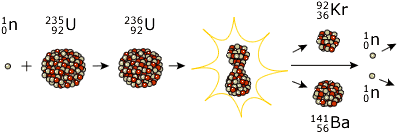|
What is Fission? |
|||
|
SplittingAssume that a heavy nucleus can be split in two medium-sized nuclei: the mass of the heavy nucleus is larger than the sum of the masses of the two parts. The difference in masses, using the Einstein equation, corresponds to an energy of about 200 MeV. This energy release for the splitting of one nucleus is very large compared to the energy release in chemical reactions, actually 10-100 million times larger! |
Fission of 236Uranium |
||||
The key to producing the splitting of a heavy 235Uranium nucleus is the neutron, discovered by Chadwick in 1932. Being neutral, the neutron is not stopped by repulsion when approaching a nucleus and a new, heavier nucleus is produced. When a neutron is captured by a 235Uranium nucleus, a heavier 236U is formed. |
It turns out that this nucleus is unstable and quickly splits in two parts, and undergoes fission. The first experiments to establish fission were performed in Berlin in 1938 by Otto Hahn and collaborators. The interpretation in terms of fission were worked out together with Lise Meitner and Otto Frisch. |
|||
 |
||||
The First Reactor: Fermi 1942 |
||||
Even if 200 MeV is a large amount of energy for one fission reaction, to make energy on a macroscopic level requires a large number of reactions. The key to this is the fact that in the fission of 236U a few neutrons (2-3) are produced (discovered 1939). |
These can, in turn, produce new fissions, i.e. start a chain reaction. The first chain reaction - the first reactor - was made in a famous experiment by Fermi in 1942. |
|||
 |
||||
|
||||
|
The Atomic Bomb and Nuclear EnergyFermi's 1942 experiment made it clear that if the chain reaction is not controlled, the result would be an explosion. The atomic bomb was a reality in 1945. The first nuclear reactor producing energy was started in 1954 in Obninsk, Russia. |
|||
See also... |
| The Nobel Prize in Physics 1935 - James Chadwick » |
| The Nobel Prize in Physics 1938 - Enrico Fermi » |
| The Nobel Prize in Chemistry 1944 - Otto Hahn » |